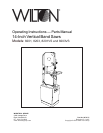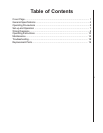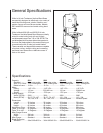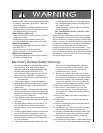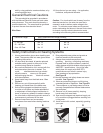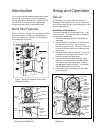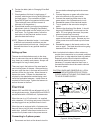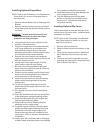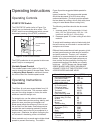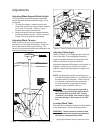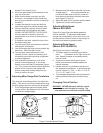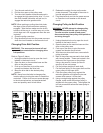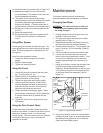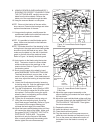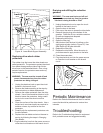
8
6. Tension the belts (refer to Changing Drive Belt
Position).
7. Check gearbox fluid level in sight gauge. If
required, add lubricant to bring level halfway up
the sight gauge. (Two containers of Shell
Spirax 90 HD gear oil are packed with the saw.
The containers have sufficient amount of
lubricant to fill the gearbox.)
8. Check blade tension and support mechanism
adjustment (refer to Changing Saw Blades).
9. Plug the motor cable into the switch box on the
saw frame. For 3-phase motors, follow the
instructions in the Electrical section to com-
plete the electrical hookup.
NOTE: Observe all electrical codes. Local codes
or difficult environmental conditions may de-
mand special electrical hook-ups. Always use a
licensed electrician for any special electrical
hook-up.
Setting-up Saw
The saw should be bolted securely to the shop
floor to make sure the saw is stable when sawing
long, heavy or unwieldy work pieces. Always use
extra support for long or heavy stock.
There are lugs in the bottom of the saw base for
use in bolting down of the saw. After positioning
the saw, open the door in the base and mark the
positions of the four lug holes. Move the saw to
expose the marks. Prepare for attachment as
required by the attachment method being used.
Install the applicalbe fasteners. Install shims as
required to level the saw. Tighten the fastners to
secure the saw to the floor.
Electrical
Models 8201 and 8201VS are delivered with a 115
volt single phase motor. Models 8203 and 8203VS
are delivered with a 220/440 volt, 3-phase motor.
When the saw is a 115 volt model, it is supplied
with a standard 115 volt plug and power cord which
can be plugged into any suitable branch circuit.
When the saw is equipped with a 3-phase motor
there will be no plug on the 4-wire cable to the saw
switch box. Instead, follow these instructions to
connect the 3-phase motor to the power source:
Connecting to 3-phase power
1. Disconnect and lock out the branch circuit to
the saw before attempting electrical connec-
tions.
2. Connect the green or green-with-white-trace
wire to the branch circuit ground wire.
3. Connect the remaining three wires to the
power wires in the 3-phase branch circuit.
4. Reestablish power in the electrical branch.
5. Turn on power to the saw motor using the
switch.
6. Observe the direction of the blade. It should
be going DOWNWARD, into the slot on the
table. If it is not going downward, the power
wires are hooked-up incorrectly.
7. To correct hook-up, disconnect and lock out
power to the branch, again. Reverse any two
of the power wires on the hook-up to the saw
cable.
8. Reestablish power in the branch and turn the
saw on again. The blade should now be going
downward into the table slot.
Note: local electrical codes or other codes may
require direct connection to a covered, protected
junction box, or other electrical hook-up method.
Especially under difficult industrial conditions,
specialized electrical connections may be
necessary. For special electrical hook-ups, a
licensed electrician should be used to connect
the saw to power.
CAUTION: KNOW AND OBSERVE ALL LOCAL
AND OTHER APPROPRIATE ELECTRICAL
CODES WHEN ATTACHING THIS BAND SAW
TO YOUR POWER SUPPLY.
Figure 4: Wiring Diagrams
1-ph.
power
source
3-ph.
power
source
Motor
Motor
Ground lug
Ground lug
Plug
Plug
Green or green
with white trace
Green or green
with white trace
Switch
Switch



